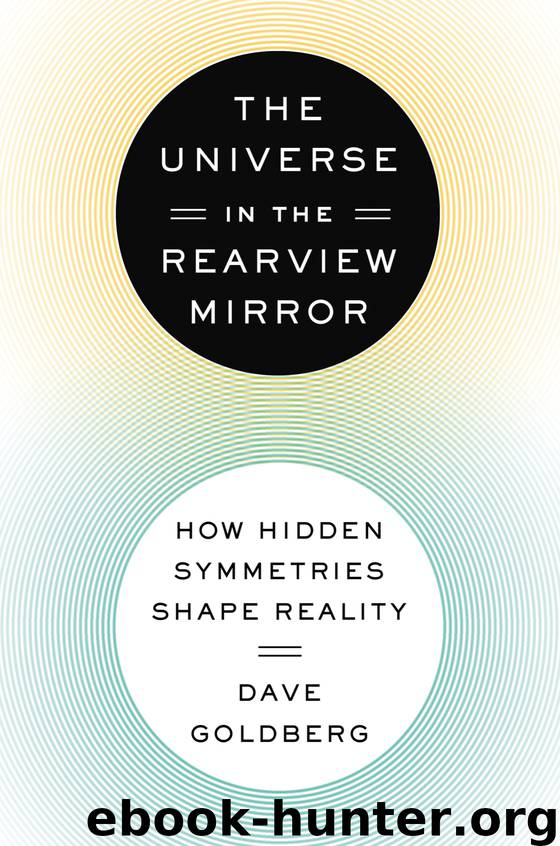The Universe in the Rearview Mirror by Dave Goldberg

Author:Dave Goldberg
Language: eng
Format: epub
Publisher: Penguin Group US
Published: 2013-06-13T16:00:00+00:00
LIFE NEAR THE EVENT HORIZON
All of the gravitational effects we’ve seen so far, from Antworld to earth to the gravitational lensing effects of the sun, are small potatoes in the scheme of things. But there are a few places in the universe where the bending of spacetime is overwhelming, such as near the surfaces of black holes.
While the blackness of the black holes precludes us from seeing them directly, we are fairly certain that they are real. Almost every large galaxy, including our own, seems to have a supermassive black hole at the center—some as much as a billion times the mass of the sun—dominating the motions of the central stars.
Black holes are ridiculously simple objects, or at least the nonrotating ones are, which are the only ones I’m going to talk about here. They consist of an infinitely compact “singularity” at the center and an outer boundary known as an event horizon—the point of no return. They are tiny, at least on an astronomical scale. If our sun were to collapse into a black hole, it would be smaller in radius than the city of Philadelphia.* Even the 4 million solar mass black hole at the center of the Milky Way could comfortably fit inside the orbit of Mercury.
Black holes are the bears of the cosmos. They’re dangerous, but they won’t hurt you so long as you don’t get too close. If the sun were to turn into a black hole, the earth would not get sucked inside. Instead, about 8 minutes and 19 seconds after the transformation—the amount of time for light to reach us—you’d see the sun appear to blink out of existence and you’d subsequently freeze to death. But in your dying hours, you’d no doubt be struck by the fact that J. J. Abrams lied to you. Rather than get pulled into the black hole sun, the earth would just keep orbiting that seemingly empty point in the sky, exactly as it always had. Only icier.
But close in, where gravity is strong, it’s a whole different story. Mercury is the innermost planet, which means that it feels the sun’s gravity more strongly than the rest of us. Even though Mercury is only twice as close in as earth, there are still some hints of how Newton was wrong and Einstein was right.
Newton, and Kepler, found that all of the planets are supposed to orbit the sun in perfectly repeating ellipses. But something seems to be wrong with Mercury, which precesses by about 2 degrees per century. This simply means that rather than make a perfect ellipse, the orbit makes a rosette pattern. For the most part, this can be totally explained by the ordinary Newtonian influences of the other planets, especially Jupiter. But a small effect—about 43 arcseconds per century—is totally inexplicable in Newton’s theory. The precession of Mercury makes sense only if you realize that spacetime near the sun is curved.
If the sun were a black hole, we could get much, much closer, and the effects of gravity would be much, much more dramatic.
Download
This site does not store any files on its server. We only index and link to content provided by other sites. Please contact the content providers to delete copyright contents if any and email us, we'll remove relevant links or contents immediately.
The Complete Stick Figure Physics Tutorials by Allen Sarah(7338)
Secrets of Antigravity Propulsion: Tesla, UFOs, and Classified Aerospace Technology by Ph.D. Paul A. Laviolette(5333)
Thing Explainer by Randall Munroe(3910)
The River of Consciousness by Oliver Sacks(3572)
The Order of Time by Carlo Rovelli(3162)
How To by Randall Munroe(3074)
A Brief History of Time by Stephen Hawking(2992)
I Live in the Future & Here's How It Works by Nick Bilton(2960)
What If?: Serious Scientific Answers to Absurd Hypothetical Questions by Randall Munroe(2669)
The Great Unknown by Marcus du Sautoy(2662)
Midnight in Chernobyl by Adam Higginbotham(2516)
Blockchain: Ultimate Step By Step Guide To Understanding Blockchain Technology, Bitcoin Creation, and the future of Money (Novice to Expert) by Keizer Söze(2467)
Networks: An Introduction by Newman Mark(2382)
The Meaning of it All by Richard Feynman(2319)
Easy Electronics by Charles Platt(2308)
The Tao of Physics by Fritjof Capra(2247)
Midnight in Chernobyl: The Untold Story of the World's Greatest Nuclear Disaster by Adam Higginbotham(2196)
When by Daniel H Pink(2098)
Introducing Relativity by Bruce Bassett(2097)
